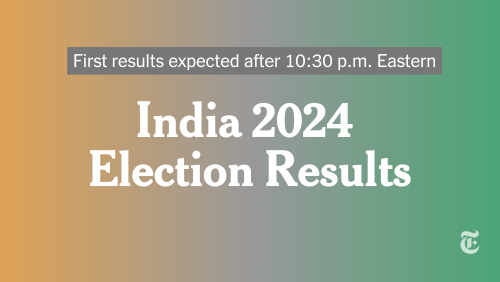
Early results from India’s general election are showing unexpected challenges for the two-term Prime Minister Narendra Modi. As votes are being counted, the outcome suggests a potentially narrower majority for Modi’s ruling coalition.
Current Standings
- National Democratic Alliance (N.D.A.): 43 seats won, 244 leading
- Indian National Developmental Inclusive Alliance (INDIA): 14 seats won, 219 leading
Although Modi’s Bharatiya Janata Party (B.J.P.) is on track to secure the most parliamentary seats, the coalition may only slightly exceed the 272 seats required for a majority. This is below their campaign target of 400 seats, highlighting a competitive election landscape.
Election Background
Bharatiya Janata Party (B.J.P.): The B.J.P. has been the ruling party since 2014, following a decisive victory over the Indian National Congress-led coalition. Originating from a century-old Hindu nationalist movement, the B.J.P. has focused on economic reforms during its first term (1998-2004) and shifted towards Hindu-centric policies under Modi. In the 2019 elections, the B.J.P. secured 303 seats.
Indian National Congress (INC): Formed in 1885, the INC played a pivotal role in India’s independence movement and has dominated Indian politics post-independence. Despite a decline in recent decades, the INC remains a significant force. In the 2019 elections, it won 52 seats.
Coalition Dynamics
In the lead-up to the election, about three dozen opposition parties united to form the Indian National Developmental Inclusive Alliance (INDIA). This grand coalition aimed to consolidate votes against Modi’s formidable B.J.P. and its allies within the National Democratic Alliance (N.D.A.).
Modi’s campaign emphasized his leadership and the promise of keeping India on a progressive path. However, his opponents warned that his continued leadership could threaten India’s democratic and secular foundations.
Key Constituencies
Here are the results from selected constituencies:
N.D.A. Strongholds
- Srikakulam, Andhra Pradesh: Kinjarapu Rammohan Naidu +26 points
- Vijayawada, Andhra Pradesh: Kesineni Sivanath +21 points
- Guntur, Andhra Pradesh: Chandra Sekhar Pemmasani +25 points
- Arunachal West, Arunachal Pradesh: Kiren Rijiju +25 points
INDIA Coalition Wins
- Wayanad, Kerala: Rahul Gandhi +34 points
- Kannur, Kerala: K. Sudhakaran +10 points
- Malappuram, Kerala: E. T. Mohammed Basheer +28 points
Other Constituencies
- Guwahati, Assam: Bijuli Kalita Medhi +15 points
- Jammu, Jammu & Kashmir: Jugal Kishore +10 points
Potential Outcomes and Analysis
The early results indicate a tighter race for the B.J.P. than anticipated. While Modi is poised to become only the second Indian leader to start a third consecutive term, the reduced majority could signal growing opposition and challenges ahead. The narrow lead may impact the government’s ability to pass significant legislation without substantial coalition support.
The grand opposition coalition, INDIA, has shown that uniting various parties can create a formidable challenge to the dominant B.J.P., reflecting a more diverse political landscape.
Historical Context
Narendra Modi has been a central figure in Indian politics, known for his decisive leadership and economic reforms. However, his tenure has also been marked by controversies and criticism over his Hindu nationalist agenda. The B.J.P.’s rise under Modi transformed India’s political dynamics, emphasizing a strong central leadership and majoritarian policies.
The Indian National Congress, with its deep roots in India’s independence and post-independence history, continues to strive for relevance in modern politics. The formation of the INDIA coalition represents a strategic effort to counter the B.J.P.’s dominance by leveraging collective strength.
Conclusion
As the counting continues and final results are awaited, the 2024 general election appears to reflect a more competitive and fragmented political environment. The outcome will shape India’s political trajectory and test the resilience of Modi’s leadership and policies.
General Disclaimer: This article is for informational purposes only and reflects the current understanding and opinions regarding the events described. The information provided is accurate to the best of our knowledge at the time of publication. Always verify details and consult with professionals before making any decisions based on this content.








